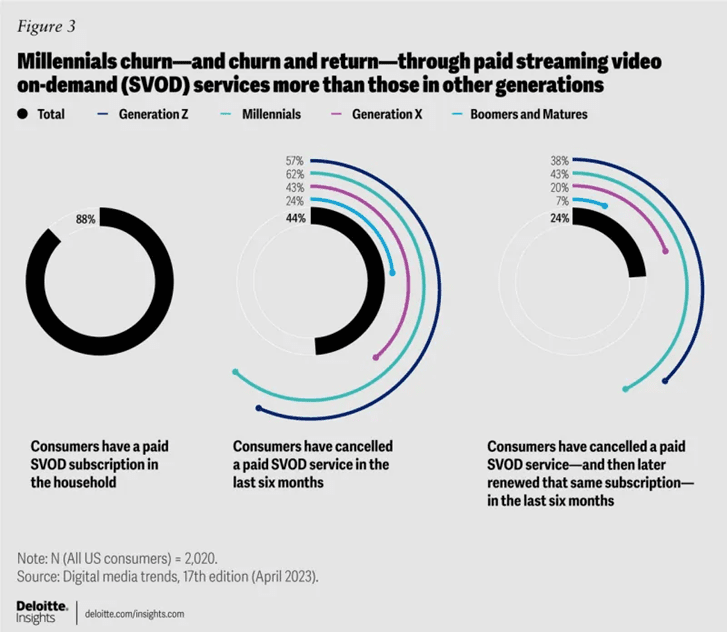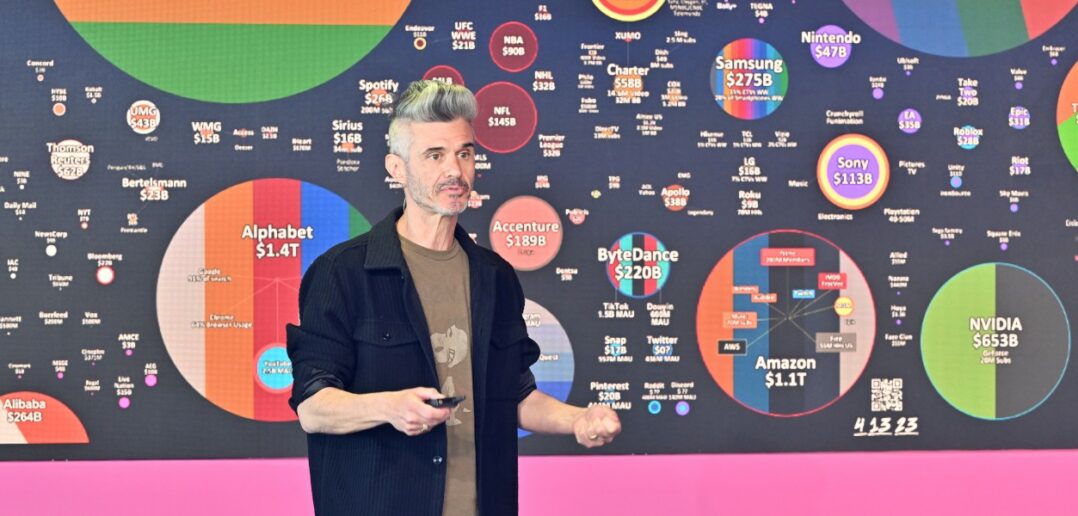One of my MIPTV 2023 highlights was Evan Shapiro’s Mastermind Keynote on the changing media landscape and how producers and studios must change their mindsets to adapt to the new content world we are entering. He said that “relevance and freshness” are key to streamers’ success in the current ecosystem and that he forecasts a “great cutting back” on SVOD subscriptions as consumers choose to change what they are subscribing to almost every month. “What used to be linear-channel changing has become streamer churn,” he explained. Now, Deloitte’s latest Digital Media Trends report already confirms his prediction that “subscription fatigue” among consumers is only getting worse.
Feel the Churn: Churn Rates are Up
As the Streaming Wars continue to intensify, subscription growth rates across the industry have slowed down, while churn rates have gone up. According to Deloitte, overall subscriber churn for paid SVOD services in the last six months is 44%. For Gen Z and Millennial consumers, those numbers even jump up to 57% and 62%, respectively. Also, around a quarter of consumers have “churned and returned,” which means they cancelled a paid SVOD subscription only to renew that same subscription within a six-months period. Again, these figures jump by double digits for Gen Zs and Millennials, who often subscribe to watch specific shows and movies and then cancel when they’re done—only to resubscribe to watch a new season or film.

This behavior corresponds with the top reasons for young audiences to subscribe to a streaming service according to Evan Shapiro: Relevant Content (60%), Originals (50%), and Refresh Rate (48%).

So, it’s all about the content the SVOD services offer. And this will become even more relevant in the next year as only 7% say they will stay subscribed to all current services, while the rest say they will cut back:

According to the Deloitte study, around half of consumers (47%) say they already have made a change to their entertainment subscriptions because of current economic conditions—like cancelling a service to save money, switching to a free ad-supported version of a service, or bundling services. Around 60% of households are now using a free, ad-supported streaming video service, and roughly 4 in 10 say they watch more ad-supported streaming video than they did a year ago, whether paid or free.
Pyramid of Feeds: Social Media covers Needs
Content is King when it comes to acquiring and retaining customers. However, Kevin Westcott, a vice chair who leads the US Technology, Media & Telecommunications practice at Deloitte, said, “The race to continue to add customers by commissioning and acquiring really high-cost content will not succeed on its own.” He suggested SVOD services should invest in diversifying the content on their platforms, including considering incorporating user-generated short-form video, music, and games. “Streamers are under pressure to reinforce their core offerings, but they should also be leveraging gaming and social media, especially considering the behaviors we are seeing in younger generations. To stay competitive, SVOD providers should seriously consider how to engage broader audiences, play across diverse media properties that add value, and advance their ad platforms to better support advertisers.”
The report states that watching TV shows and movies at home is no longer the dominant, “go-to” activity it once was — especially with younger generations that are more evenly dividing their entertainment time across TV shows and movies, user-generated content (UGC) on social media services, and video games. They seek entertainment, connection, immersion and utility. Plus, more than half (54%) of consumers surveyed – and nearly three-quarters of Gen Z and Millennials – said they often watch a TV show or movie on a streaming video service after hearing about it on social media.
Per Evan Shapiro’s Pyramid of Feeds, Social Media is the most important feed overall:

Think Global, Stream Local: Rise of Local Content
What surprised me the most, though, was that local streamers are ahead of Netflix & Co. in Europe. They can’t reach the biggest UGC-platform YouTube, but they leave the global streamers behind.
Local content allows for a more authentic representation of a particular culture, region, or community. As audiences increasingly seek diverse and culturally relevant content, there is a growing demand for locally produced content that reflects their own experiences and perspectives. Furthermore, local content can target niche markets and underserved audiences that may be overlooked by mainstream or international productions. By creating content specifically tailored to these audiences, content creators can tap into passionate fan bases and build loyal followings. Personalization and curation by targeting niche audiences is also one of the reasons for the Rise of FAST Services in recent years.
Both, local and global content will continue to coexist, catering to different preferences and serving various purposes within the evolving landscape of the content industry. But for the moment, it’s interesting to see that local European streamers are ahead of global streamers.
Live is Live: Create FOMO
Year after year, live sporting events as well as live news coverage completely dominate linear TV ratings and keep the old way of watching TV on life support. The streamers are catching up, though, when it comes to live content: Amazon has been streaming NFL games in the US and the UEFA Champions League in Europe, Netflix had their first live Comedy Special with Chris Rock back in March, and Apple TV just launched its MLS Season Pass add-on with live-streaming soccer.
Live content creates a sense of urgency and exclusivity. Viewers may have FOMO (fear of missing out) regarding unique moments or experiences that are only available in real-time. This drives viewership and encourages users to tune in live to be part of the shared experience. Live Content also presents various monetization opportunities for platforms. These include sponsorships, ad placements, merchandise sales, and premium subscriptions for exclusive live access. And finally, and again, live content is more social. Viewers can engage through live chat, comments, real-time feedback, creating a sense of community and participation. This interactive element enhances viewer engagement and loyalty.
All in all, I believe the future of streaming is social, local, and live. Since social is the magic ingredient to reach and retain new audiences, though, I will tell you in part two why the future of streaming is also social, interactive, and immersive. But for now, catch up on Evan Shapiro’s Mastermind Keynote in a nutshell on our brand-new TikTok channel.




